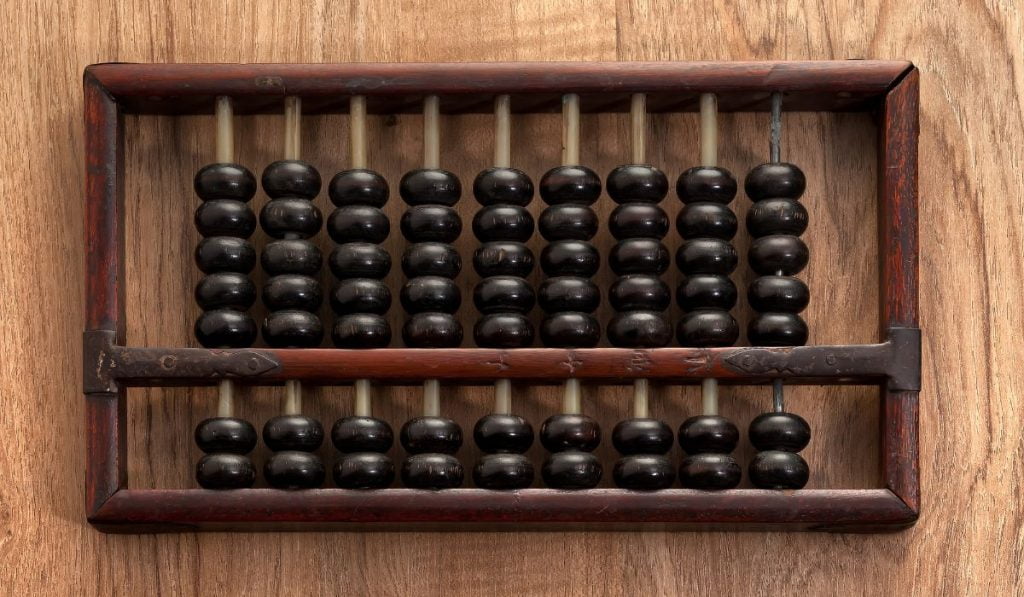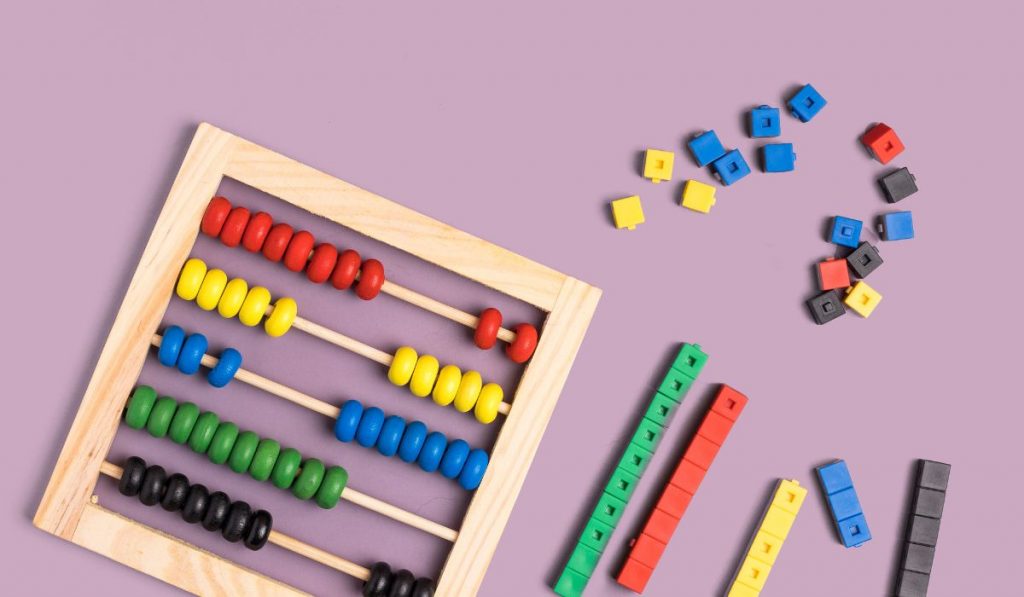The abacus is something most of us have interacted with, especially when we were kids and just started to learn how to count. We’d move those white and red beads and learn what 2 looked like, what 5 looked like, and so on.
Several centuries back the Abacus was the best and fastest way to do math. It might sound funny today, with our phone integrated calculators, but it was popular back in the day and had to be invented by someone, but who?
Mesopotamians invented the first version of an abacus, sometime between 2700 BC and 2300 BC. This early form of abacus used a base 60 system (as opposed to our base 10), and several columns to represent the successive orders of magnitude in their number system.
The physical form of this abacus was never recorded, but the belief was that it was a tablet with grooves cut into it (the columns), and pebbles moved across those columns.
Different Types of Abacus
So how did we get to the abacus we know today ? The road from the ancient abacus is long, and it starts with the Mesopotamians, but they were just the first. Several civilizations contributed to making the abacus much more common, so let’s take a look at how it happened.

Egyptians Slabs and Columns
Ancient Egyptians did not use an abacus as the Mesopotamians did, but the concept was very similar. They used large slabs with columns and moved the pebbles right to left, as was usual in that part of the world.
Persian Scholars and the Abacus
The abacus Persians used was also not the frame and beads version we may think of. It was a slab with rows cut into it, and again pebbled were moved across the row to show numbers.
The abacus found its way to other countries sometime after 600 BC. Trading was in full swing, but Persians also started trading knowledge with their immediate neighbors, such as India, China, Russia, and the Roman Empire. As trading continued, the abacus and the knowledge of how to use it became common throughout the world.
That is to say, it’s not like other nations didn’t know how to calculate their sums for trade, they did. They just didn’t use the abacus as extensively, until Persian scholars began imparting knowledge.
Ancient Romans Developed A Counting Board
Ancient Romans had developed a version of a simpler, base 10 counting board that was based on Greek and Babylonian abacus. This version was a rectangular slab, had several rows that had pre-set pebbles in them, and they could be moved up-down (or left-right) to show numbers and make various calculations.
This version of the abacus/counting board became widespread throughout the Roman empire, and it was used throughout Europe until close to the 19th century AD. In the meantime, the beaded abacus was introduced in the 11th century AD by Pope Sylvester II. Both the abacus and the Roman counting board were used throughout Europe, with the Roman counting board losing popularity because the beaded abacus was faster and easier to use.
The Chinese suanpan: Dates Back to 2 BC
The suanpan is a rectangular wooden tray, with several rods with wooden beads on them. There is a beam separating the rods left-right. The beads are moved on the rods in order to do various mathematical calculations, similar to the beaded abacus we know today. The suanpan was widely used throughout China, as trading took off, their version of counting (beaded frame vs counting tablet) became more widespread.
It’s entirely possible that this version of abacus (the suanpan) eventually reached the countries surrounding China, including Russia and Japan, and then Europe. It’s also very possible that Pope Sylvester II based his modified abacus on the suanpan that may have reached Europe. The Silk Road was un use up until the 14th century AD, and Pope Sylvester II introduced the beaded abacus in the 11th century.
In Japan, a very similar counting tool was the soroban, and it was heavily inspired by the suanpan. It was introduced in the 14th century in Japan by scholars and traders, and it took almost 3 centuries to be fully adopted for everyday use.
The Russians also based their abacus, called schoty, on the suanpan. However this version does not have a beam down the middle, to separate the beads.
All beads are moved from the right to the left in order to calculate anything, and the schoty can be reset by moving all the beads to the right. This is the version closest to what we usually imagine nowadays when we think of an abacus, and it’s still in use today in some parts of Russia.
When was the abacus invented ?
Earliest abacus was invented in 2700-2300 BC Mesopotamia. Abacus stands for ‘rectangular material’, from the ancient Greek abax. So the very early version of an abacus did not necessarily have beads on wires, but was instead a flat slab with rows carved into it, and pebbles moved along those rows.

The version of an abacus that is closer to a modern abacus dates back to 2 AD China, where it was a wooden frame with wooden beads on rods. This type of abacus found its way to China’s neighboring countries and areas, and even wound up in Europe through the Silk Road.
Why was the abacus invented ?
The abacus was invented as a way to aid calculus. It was a key item in math, capable of subtraction, addition, multiplication, division, and even square and cube roots.
Various civilizations came up with a version of an abacus, with the main versions being the counting tablet (or board) and the wooden frame with beads. The logic and system behind both versions was extremely similar but it turned out the beaded abacus was faster and easier to manipulate than the flat abacus (counting tablet).
Not only was the beaded abacus easier to work with, it was lighter and could easily be carried around. Compared to the larger, heavier counting boards, this was a huge advantage as it meant you could calculate whatever you needed on the go.
Interesting facts about abacus
The abacus is both useful and interesting, and it’s not completely out of the picture today. Abacuses are still being made today, to aid in teaching arithmetics and to help kids visualize numbers.
Many countries taught early math with abacus, until recently
Russia for example used the schoty (their version of an abacus) to teach early math in elementary school, up until the early ’90s. The use of schoty was so common throughout Russia and its occupied lands (at the time) that many countries under Russian influence used this method as well.
This was such an old and common practice that it was universally used by shopkeepers and traders, to the point where modern calculators were slower and clunkier by comparison. Of course, this was because of the great skill of abacus users, not because of a fault in the calculators. The schoty abacus still remains in use for older generations who grew up with it.

Similarly, Turkey and Armenia used their own abacus, very similar to the Russian schoty, for a very long time. China and Hong Kong also taught the use of their abacus (suanpan) up until the mid and late 1900s.
Is the Abacus Still Used Today?
If you walk into a regular corner shop in Asia, you’ll find shopkeepers still using an abacus, and with lightning reflexes. While younger generations have interacted with an abacus before, they didn’t rely on it. Instead, generations before them were raised with an abacus, and were taught to do all math operations on it. They’re developed such skill that for them it’s much faster to compute anything on an abacus than a micro calculator.
And if you’re in North America, you might see these shopkeepers in action in your local Chinatown or a similar predominantly-Asian area.
Read Also: Who Invented The Watch?
The oldest surviving version of an abacus dates back to 300 BC
By oldest version I mean oldest item that is still intact, and could still be used today. It’s very likely not the first counting tool ever made, but it’s the one that has survived for the longest time.
It’s the Salamis counting board, and it was first discovered on the Greek island of Salamis, in 1864 AD. It was carbon dated back to 300 BC, and it looks quite differently from an abacus. It’s a slab of white marble, with horizontal groves cut into it. Small pebbles would be used to represent small numbers, and they’d be moved left-right much like the abacus we know today, but they weren’t attached to the tablet itself.
This type of counting board or tablet was the basis for the Roman counting tablet that eventually took off in early Europe.

